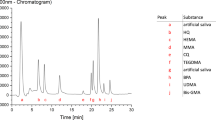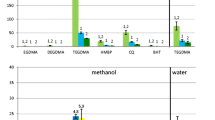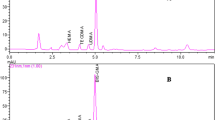Abstract
This study investigated the leaching of ingredients from several commercial dental composite resins cured with LED, and immersed in methanol or water for 24 h, respectively. The composites used were: Admira Dentin (VOCO), Artemis Schmelz (Enamel) (Ivoclar Vivadent), Els extra low shrinkage (Saremco Dental), Filtek Supreme XT Dentin (3 M ESPE), Gradia Direct (GC), Venus & Venus flow (Heraeus Kulzer), and XRV Herculite Prodigy Enamel (Kerr). From each dental composite four specimens with defined structure and 100-mg net weight were made. After the polymerization process, according to manufacturer's instructions, the specimens were immersed in either 1 ml water or 1 ml methanol and incubated at 37°C for 24 h. Eluted ingredients triethyleneglycoldimethacrylate (TEGDMA), 2,6-di-tert-butyl-4-methylphenol (BHT), and 4-N,N-dimethylaminobenzoicacidethylester (DMABEE) were detected and quantified using gas chromatography–mass spectrometry (GC–MS). The amounts of the detected analytes from 100 mg polymerized composites ranged between the following values: TEGDMA: 0–0.5 mg (water), 0–1.6 mg (methanol); BHT: 0–0.03 μg (water), 0–0.11 mg (methanol); and DMABEE: 0–0.11 mg (water), 0–1.4 mg (methanol). We conclude from the results that the elution rates into methanol and water differ significantly. Furthermore, it is concluded that all the determined amounts eluting from the composites are far below toxic-relevant concentrations.



Similar content being viewed by others
References
Al-Hiyasat A, Darmani H, Milhem M (2005) Cytotoxicity evaluation of dental resin composites and their flowable derivatives. Clin Oral Invest 9(1):21–25
Chowdhury N, Wakasa K, Priyawan R, Yamaki M (1996) Matrix strengthening in new ternary bis-GMA/TEGDMA/urethane resin systems. J Mater Sci Lett. 15:1912–1915
Chung K, Greener E (1988) Degree of conversion of seven light-cured posterior composites. J Oral Rehabil 15:555–562
Cimpan MR, Matre R, Skaug N, Lie SA, Lygre H (2005) The coinitiator DMABEE induces death by apoptosis and necrosis in human monoblastoid cells. Clin Oral Invest 9(3):168–172
Dolez P, Marek M, Love B (2001) Photopolymerizable acrylic resin: effect of curing time and temperature. J Appl Polym Sci 82:546–554
Emmler J, Seiss M, Kreppel H, Reichl F, Hickel R, Kehe K (2008) Cytotoxicity of the dental composite component TEGDMA and selected metabolic by-products in human pulmonary cells. Dent Mater. 24:1670–1675
Ferracane J (1994) Elution of Leachable Components from Composites. J Oral Rehabil. 21(4):441–452
Ferracane J, Condon J (1990) Rate of elution of leachable components from composite. Dent Mater 6:282–287
Geurtsen W (1998) Substances released from dental resin composites and glass ionomer cements. Eur J Oral Sci 106(2 Pt 2):687–695
Geurtsen W, Lehmann F, Spahl W, Leyhausen G (1998a) Cytotoxicity of 35 dental resin composite monomers/additives in permanent 3T3 and three human primary fibroblast cultures. J Biomed Mater Res 41:474–480
Geurtsen W, Lehmann F, Spahl W, Leyhausen G (1998b) Cytotoxicity of 35 dental resin composite monomers/additives in permanent 3T3 and three human primary fibroblast cultures. J Biomed Mater Res 41(3):474–480
Graham I, Mount W (2005) Preservation and restoration of tooth structure, 2nd edn. Knowledge Books and Software, Queensland
Gressani SL-K, O’Sullivan MG, Case LD, Malkinson AM, Miller MS (1999) Strain-dependent lung tumor formation in mice transplacentally exposed to 3-methylcholanthrene and post-natally exposed to butylated hydroxytoluene. Carcinogenesis 20(11):2159–2165
Inoue K, Hayashi I (1982) Residual monomer (Bis-GMA) of composite resins. J Oral Rehabil 9:493–497
Kanerva L, Estlander T, Jolanki R (1989) Allergic contact dermatitis from dental composite resins due to aromatic epoxy acrylates and aliphatic acrylates. Contact Dermat. 20(3):201–211
Kodaka T, Kobori M, Hirayama A, Abe M (1999) Abrasion of human enamel by brushing with a commercial dentifrice containing hydroxyapatite crystals in vitro. J Electron Microsc 48(2):167–172
Lanigan R, Yamarik T (2002) Final report on the safety assessment of BHT. Int J Toxicol 21(2):19–94
Lee SY, Huang HM, Lin CY, Shih YH (1998) Leached components from dental composites in oral simulating fluids and the resultant composite strengths. Journal of Oral Rehabilitation 25(8):575–588
Lygre H, Høl P, Solheim E, Moe G (1999) Organic leachables from polymer-based dental-filling materials. Eur J Oral Sci. 107:378–383
McKinney J, Wu W (1985) Chemical softening and wear of dental composites. J Dent Res 64:1326–1331
Michelsen V, Lygre H, Skalevik R, Tveit A, Solheim E (1998) Identification of organic eluates from four polymerbased dental filling materials. Eur J Oral 26(2):263–271
Michelsen V, Lygre H, Skalevik R, Tveit A, Solheim E (2003) Identification of organic eluates from four polymer-based dental filling materials. Eur J Oral Sci. 111:263–271
Nakagawa Y, Tayama K, Nakao T, Hiraga K (1984) On the mechanism of butylated hydroxytoluene-induced hepatic toxicity in rats. Biochem Pharmacol. 33:2669–2674
Nathanson D, Lertpitayakun P, Lamkin MS, Edalatpour M, Chou LL (1997) In vitro elution of leachable components from dental sealants. J Am Dent Assoc 128(11):1517–1523
Ortengren U, Wellendorf H, Karlsson S, Ruyter I (2001) Water sorption and solubility of dental composites and identification of monomers released in an aqueous environment. J Oral Rehabil 28(12):1106–1115
Polydorou O, Trittler R, Hellwig E, Kümmerer K (2007) Elution of monomers from two conventional dental composite materials. Dent Mater 23:1535–1541
Reichl F, Durner J, Hickel R, Spahl W, Kehe K, Walther W, Gempel K, Liebl B, Kunzelmann K, Hume W (2002) Uptake, clearance and metabolism of TEGDMA in guinea pigs. Dent Mater 18:581–589
Santerre J, Shajii L, Leung B (2001) Relation of dental composite formulations to their degradation and the release of hydrolyzed polymeric-resin-derived products. Crit Rev Oral Biol Med. 12:136–151
Schweikl H, Altmannberger I, Hanser N, Hiller K, Bolay C, Brockhoff G, Spagnuolo G, Galler K, Schmalz G (2005) The effect of triethylene glycol dimethacrylate on the cell cycle of mammalian cells. Biomaterials. 26(19):4111–4118
Schweikl H, Spagnuolo G, Schmalz G (2006) Genetic and cellular toxicology of dental resin monomers. J Dent Res 85(10):870–877
Sideridou I, Achilias D (2005) Elution study of unreacted Bis-GMA, TEGDMA, UDMA, and Bis-EMA from light-cured dental resins and resin composites using HPLC. J Biomed Mater Res B 74B(1):617–626
Sikkema J, de Bont J, Poolman B (1994) Interaction of cyclic hydrocarbons with biological membranes. J Biol Chem 269:8022–8028
Sletten G, Dahl J (1999) Cytotoxic effects of extracts of compomers. Acta Odontol Scand 57:316–322
Spahl W, Budzikiewicz H, Geurtsen W (1998) Determination of leachable components from four commercial dental composites by gas and liquid chromatography mass spectrometry. J Dent 26(2):137–145
Stanislawski L, Lefeuvre M, Bourd K, Soheili-Majd E, Goldberg M, Périanin A (2003) TEGDMA-induced toxicity in human fibroblasts is associated with early and drastic glutathione depletion with subsequent production of oxygen reactive species. J Biomed Mater Res A. 66(3):476–482
Tanaka K, Taira M, Shintani H, Wakasa K, Yamaki M (1991) Residual Monomers (TEGDMA and Bis-Gma) of a set visible-light-cured dental composite resin when immersed in water. J Oral Rehabil 18(4):353–362
Wada H, Tarumi H, Imazato S, Narimatsu M, Ebisu S (2004) In vitro estrogenicity of resin composites. J Dent Res 83(3):222–226
Wan Q, Rumpf D, Schricker S, Mariotti L, Culbertson B (2001) Influence of hyperbranched multi-methacrylates for dental neat resins on proliferation of human gingival fibroblasts. Biomacromolecules 1:217–222
Wu W, McKinney J (1982) Influences of chemical on wear of dental composites. J Dent Res 61:1180–1183
Yamaki K, Taneda S, Yanagisawa R, Inoue K, Takano H, Yoshino S (2007) Enhancement of allergic responses in vivo and in vitro by butylated hydroxytoluene. Toxicol Appl Pharmacol. 223:164–172
Author information
Authors and Affiliations
Corresponding author
Rights and permissions
About this article
Cite this article
Seiss, M., Langer, C., Hickel, R. et al. Quantitative determination of TEGDMA, BHT, and DMABEE in eluates from polymerized resin-based dental restorative materials by use of GC/MS. Arch Toxicol 83, 1109–1115 (2009). https://doi.org/10.1007/s00204-009-0470-7
Received:
Accepted:
Published:
Issue Date:
DOI: https://doi.org/10.1007/s00204-009-0470-7




